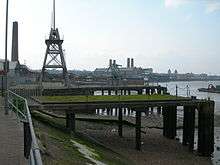Enderby's Wharf

Enderby's Wharf is a wharf and industrial site on the south bank of the Thames in Greenwich, London, associated with Telcon and other companies. It has a history of more than 150 years of production of submarine communication cables and associated equipment, and is one of the most important sites in the history of submarine communications.
Location
The wharf lies on the Greenwich Peninsula a little to the north of the historic centre of Greenwich between the Thames and just south of the Blackwall Tunnel approach road, across the river from Cubitt Town. It covers an area of some 16 acres (65,000 m2) and has a frontage of around 600 feet (180 m).
History
The wharf was first developed commercially by the whaling company of Samuel Enderby & Sons. The site was first acquired by Samuel Enderby II, with Morden College assisting in the acquisition of the Naval Ammunition wharf. Henry Vansitart before he became an Admiral did the initial wharf building along the River frontage. It was Samuel Enderby III who initially developed the site along with brothers Charles and George, who acquired the site for a ropeworks. Enderbys also built Enderby House in the early 1830s; this remains today as a listed building[1] and part of the Alcatel works on the site.
In 1857 submarine cable manufacturers Glass, Elliot & Co and W.T.Henley took over the site; Henleys subsequently moved to North Woolwich.[2] As well as jointly making the short-lived first transatlantic telegraph cable, Glass, Elliot supplied many early telegraph cables including Corsica–Sardinia, Lowestoft–Zandvoort, Malta–Alexandria and Sicily–Algeria. In the 1860s Glass, Elliot was absorbed into the Telegraph Construction and Maintenance Company (Telcon)[4], which manufactured a second transatlantic telegraph cable at Enderby's Wharf. This was successfully laid by the SS Great Eastern. The company went on to manufacture many more transatlantic cables, and others to Australia, New Zealand, India, Hong Kong etc.[5]
In 1935 the site came into the ownership of the newly formed Submarine Cables Ltd. Some of the cross-channel, D-Day Pluto pipeline was made at the wharf in World War 2. After ownership by BICC and AEI, in 1970 it passed to STC. Manufacture of submarine cable at the site ended in 1975 (transferring to Southampton), and work concentrated on manufacture of optical repeaters and amplifiers. It subsequently passed to Northern Telecom and then to Alcatel in 1994.[6] In 2006 Alcatel merged with US company Lucent to create Alcatel-Lucent. Since then Alcatel-Lucent has sold off a large part of its site to Barratt Developments for a housing estate, which will be called Enderby Wharf. Enderby House, the original office building, is on the Barratt site but no commercial use has yet been identified.[7] The Enderby Group was set up by a number of people from the area, including some with telecommunications connections and others with industrial archaeological experience, in September 2014 to work for a long-term viable use for Enderby House.[8]
Proposed cruise ship terminal
In 2010 a proposal was made to turn 3 acres (12,000 m2) of the river frontage of the site not in use by Alcatel into a terminal for huge cruise liners, and housing.[9] The proposal (known as 'Enderby Wharf') received planning approval from Greenwich Council in 2011, subject to approval by the Greater London Authority (GLA).[10] Mayor Boris Johnson gave his approval to a revised application for a larger terminal in August 2015.[11]
It was expected that up to 55 large cruise ships would dock there every year. Each would need to run its diesel engines continuously to power onboard facilities, generating large polluting emissions near busy residential areas and schools. While London has strict regulations on air quality and emissions, they do not apply to the Thames, which is in the jurisdiction of the Port of London Authority (PLA) rather than the GLA. At the London elections in 2016 the Conservative and Labour mayoral candidates joined their Green and Liberal Democrat rivals to support the residents' campaign against the terminal.[12] In 2018 Greenwich council changed its opinion, and called for Morgan Stanley, current owner of Enderby Wharf, to implement a less polluting solution for the cruise terminal. Residents of the area proposed it should be "zero emissions", supporting ships able to use onshore electrical power without the need to run their engines while docked. Some cruise ships already support the use of shore power, while others are being adapted to do so.[13]
See also
References
- ↑ "List of Buildings of Special Architectural or Historical Interest Index for the Borough of Greenwich" (PDF). Retrieved 14 April 2011.
- ↑ Mills, Mary (1999). Greenwich Marsh: The 300 Years Before the Dome. London: M.Wright. ISBN 0-9535245-0-7.
- ↑ "Our History". Telcon.
- ↑ A Crawley-based company called Telcon and claiming a heritage back to 1864 was spun off from BICC in 2006.[3]
- ↑ Glover, Bill. "British Submarine Cable Manufacturing Companies". History of the Atlantic Cable & Undersea Communications. Retrieved 12 April 2011.
- ↑ Green, Allan. "150 Years Of Industry & Enterprise At Enderby's Wharf". History of the Atlantic Cable & Undersea Communications. Retrieved 12 April 2011.
- ↑ "Enderby Wharf".
- ↑ "Enderby Group".
- ↑ "Planning Report PDU/2515/01 Enderby Wharf,Christchurch Way, SE10" (PDF). Greater London Authority. 2010. Retrieved 12 April 2011.
- ↑ "Greenwich cruise liner terminal plans approved". BBC. 28 January 2011. Retrieved 14 April 2011.
- ↑ https://www.telegraph.co.uk/travel/cruises/news/Londons-new-cruise-terminal-gets-the-green-light/
- ↑ https://853blog.com/2016/04/11/sadiq-khan-sides-with-enderby-wharf-campaigners-in-clean-air-battle-with-greenwich-council/
- ↑ Matthew Taylor (26 September 2018). "Air pollution fears fuel fight against new London cruise ship terminal". The Guardian. Retrieved 26 September 2018.